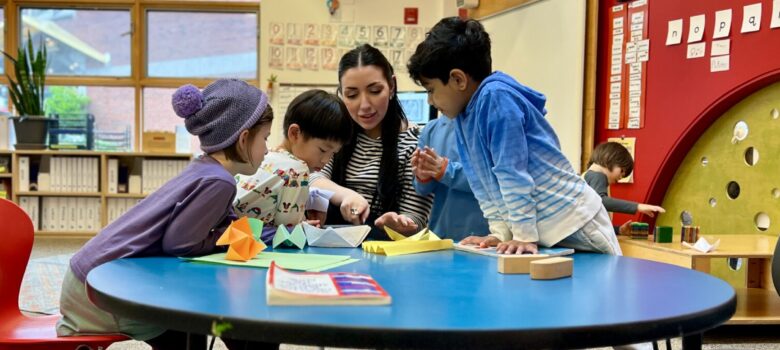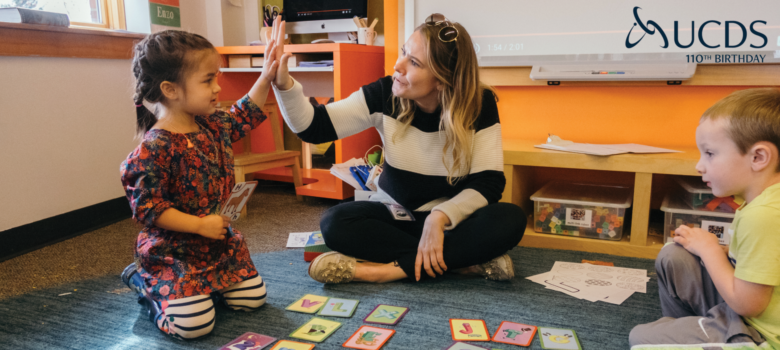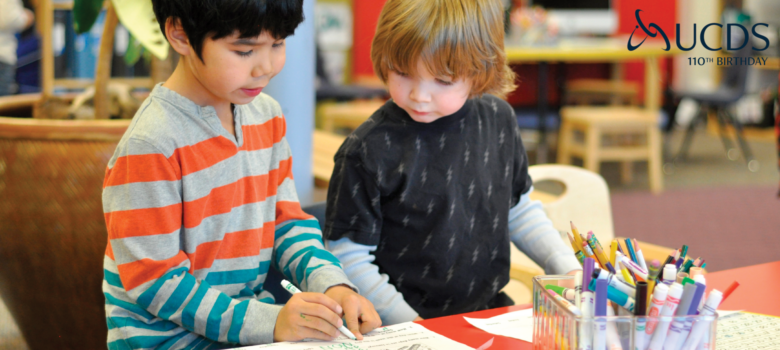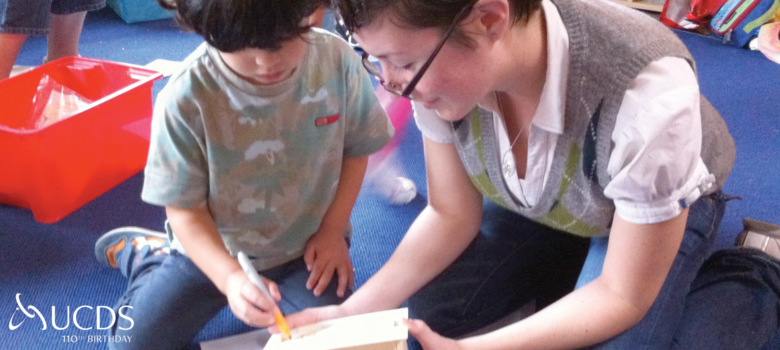Marianne Sardelich, infant room teacher at the Studio, shares her experiences introducing loose parts into the Studio’s classrooms. She describes how non-traditional play materials promote creativity and discovery -Ed.
– – – –
About three years, we dedicated a space in our building to loose parts. This was a rather significant decision because (as anyone who has ever visited the Studio before can tell you) we don’t have a lot of extra space. By turning over one whole room (albeit a very small/ former bathroom) to loose parts, we essentially made a Studio-wide commitment to using loose parts in our classrooms.
Our decision was inspired by the book Loose Parts: Inspiring Play in Young Children by Lisa Daly and Miriam Beloglovsky. We found the book in response to our wonderings about how we could expand the play that was happening in our classrooms. The games that the toddler and preschool-age children created involved cars, superheroes, babies, and other typical games. The materials that we provided usually directly represented what the child wanted the item to be i.e. pretend food in the kitchen, a carpet with roads for the cars, or tiny baby bottles. We felt that these materials weren’t stretching the children’s ability to use their imagination. They might have to find something to stand-in for a superhero tool or create a tunnel for their cars but we could tell that our materials were not supporting them in expanding on their ideas and their play. We wanted materials that provoked curiosity, whose purpose was not immediately apparent, and that could be used in many different ways.
Daly and Beloglovsky describe loose parts as “alluring, beautiful found objects and materials that children can move, manipulate, control, and change while they play.” This means that a loose part can be almost anything from sea shells, paper tubes, bottles, scarves, leaves, sticks, and almost any other thing that has more than one potential purpose. Loose parts promote children to be creative because their use is not obvious, there are an infinite number of things that any one loose part can used for, and a child either has to create based on the parts available or decide which part best fits their needs. In “How Not to Cheat Children: The Theory of Loose Parts” Simon Nicholson describes the effect that loose parts has on children’s creativity this way: “In any environment both the degree of inventiveness and creativity and the possibility of discovery are directly proportional to the number and kind of variables in it.” (Daly and Beloglovsky 2015) The Studio, we decided, needed more variables.
Our collection began with teachers going through The Studio and collecting all of the things that we already had that could be a loose part. We already had lots of natural items, bottles, jars, and cans. There was fabric leftover from various projects, buttons, and string. We shared our plan to create a loose parts closet with families and asked them to fill a bag with anything that they had at home that they thought could be used again. We organized our Loose Parts Closet, sorting materials, and displaying available items, and we began to consider how we could add them to our classrooms.
The first approach that we tried was to set them out alongside other materials in the classroom. When children went to the shelf to look for a car, they might also find a basket of pinecones. The children noticed the loose parts but we didn’t see signs of the materials being incorporated into their games. We wondered if the children needed more guidance on how to use loose parts, a chance to create with loose parts alongside a teacher, to ask questions and consider what the loose parts could do or be. The loose parts became something that came out during table activities, art projects, or during other small group experiences. But we still didn’t feel the energy around loose parts that we had expected when we decided to add them to the classroom.
Last year, the upstairs teachers decided to approach their classroom set up in a new way. In the past, we had relied on baskets to store toys and when children entered the classroom, they had to look through the baskets to find materials to use. Throughout the classroom, they designed provocations that invited children to explore a particular set of materials, consider a question, or promote a particular game or type of play. Loose parts became key players in this new approach to classroom set-up. Almost immediately we noticed a change in the way that the children used the materials. By grouping certain materials together under a particular theme, the teachers created a context for the loose parts. Red jewels were blood vessels, blue scarves became an ocean for sea animals, or paper tubes turned into binoculars for pirates. These provocations offered children ideas for how to use the loose parts while also encouraging them to think flexibly about what the loose parts represented. The teachers also supported the children in taking the loose parts and expanding on the provocation or moving to a new area of the classroom and beginning something completely different. The children were developing a language to make their thinking visible using loose parts.
This year we have seen even more of an expansion in the way that children use loose parts in the Studio. Loose parts are now the go-to materials in the classroom and we are notice that the games children play are more creative, expansive, and inclusive. Because there is not obvious an “right way” to use a loose part, the approach that our youngest children take is just as successful as the approach the oldest children take. We have also noticed that the loose parts support children to be more collaborative because they encourage children to share ideas, discuss plans, and collaborate to decide on what the loose parts could be or represent in a game. Piaget, Vygotsky, and Dewey agreed that in order to learn, children need to be able to manipulate their environments and we see this everyday in the way that children approach provocations, dismantle them, and then create something entirely new with the loose parts (Daly and Beloglovsky 2015).
As The Studio’s ability to communicate using the language of loose parts continues to develop, we wonder how the magic of loose parts can be fostered in our infant/toddler classroom. What does an infant loose parts provocation look like? Our Loose Parts Closet is more stocked than ever and we as a community have changed the way that we think about “trash”. Very frequently, you can catch one of us about to throw something away and someone else wondering, “Is that a loose part?”
Loose Parts- Inspiring Play in Young Children by Lisa Daly and Miriam Beloglovsky published in 2015 by Redleaf Press




